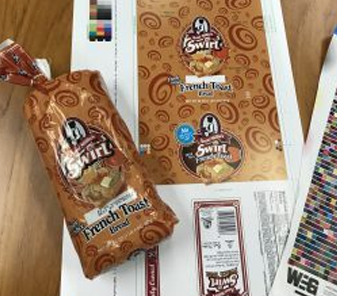By Robert Jackson, Vice President of Sales for West Essex Graphics

As the food and beverage industries prepare for the 2020-21 mandate requiring significant changes to nutrition label design, it is paramount to find ways to wholly comply with the FDA while maintaining or improving the impact of the packaging itself. With a mandate as all-encompassing as this new decree, packagers, brand owners and consumers alike will be affected by some aspect of the upcoming changes; in fact, some 80 percent of food industry items will be impacted by the new rules.
As with most regulation-based changes, getting ahead of the game is advisable, as proactive approaches can breed not only compliance but beyond-compliance opportunities for enhancements. Also, for the sake of efficiency, it is in brand owners’ best interests to make other updates to labels while the mandatory changes are made, thereby addressing label design once rather than multiple times in a relatively brief period of time. This saves both time and money.
But before we go further, let’s reiterate the looming mandate and its deadlines, because they’ve sown a bit of confusion concerning their rolling enforcement: The FDA recently extended the compliance dates for the Nutrition Facts and Supplement Facts label final rule and the Serving Size final rule, until January 1, 2020, for manufacturers with $10 million or more in annual food sales. Manufacturers with less than $10 million in annual food sales will receive an extra year to comply – until January 1, 2021.
So in other words, larger food manufacturers have a little more than a year to comply, while smaller ones have a little more than two years. That’s the blink of an eye in business.
As such, the time is now to prepare and plan for the upcoming changes. Understanding the stipulations is a crucial first step in tackling the mandate; one of the most prominent changes is the increased size of “calories” and “servings per container” in order to enhance visibility for consumers. “Serving size” will now be required to be not only larger in type size but bolded as well. The notion of “calories from fat” is no longer required to be present on nutrition labels, as research shows that the type of fat is more important than the amount within a product. These changes come as a result of consumers’ heightened awareness of nutrition and the recent push for increased clarity of nutritional facts.
In order to make the most of these changes – to make lemonade out of regulatory lemons, so to speak – food and beverage brand owners should begin the redesign of their products now. Between designing, printing and relabeling, the process can be time-consuming and overwhelming. By starting the compliance process early, companies will have ample time to properly prepare for the deadline and perfect the transition to the new labeling requirements.

Proactively preempting the rush to compliance also yields a key opportunity for efficiency and brand impact: the chance to make other design changes simultaneously, thereby “touching” packaging only once along the supply chain. Arranging packaging design updates to occur at the same time as the new labels can save time and money. This type of “two birds with one stone” strategy – achieving FDA compliance in tandem with a brand refresh or other packaging-related alterations – turns the approaching deadline from a burdensome legal issue into a welcome opportunity to truly look at your packaging design and see where it could be improved.
Amidst this landscape, an integrated approach to packaging design has never been more valuable. Whether companies choose to outsource design to an experienced agency or utilize an internal design team, the compliance mandate provides a unique opportunity to streamline packaging design updates.
For example, capitalizing on digital tools like web-based presentation platforms provides a more collaborative environment in which various stakeholders both on and offsite can review and critique designs in real time. Additionally, decision-makers can virtually view and approve photos, eliminating the need for on-set presence, and 3D renderings of completed products for print, web or in-house promotions can be hosted on secure online platforms for enhanced accessibility. These digital innovations provide convenience and transparency for clients while establishing accountability for the design team – all critical elements to a successfully centralized workflow channel.
To further streamline redesigns, a set of graphics standards guidelines establishes the foundation for layout norms and consistency throughout a project’s execution. A good example here is a sound artwork development process, where accurate reproduction of approved designs – with prioritized attention to standards adherence via one-stop photography management – is a vital first step toward any comprehensive redesign. The implementation of multiple quality control checkpoints, at both supplier and internal personnel levels, best ensures that all artwork is accurate and in compliance.
Also, proper communication with suppliers is paramount in confirming packaging specifications including size, legal copy, and nutrition information; by including this necessity in the overall streamlined workflow, the need for brand owners/clients to contact their suppliers regularly is alleviated. Thanks to a concise and efficient workflow, clients will have no need to provide final files directly to suppliers upon approval of artwork, while hard copy and digital proof approvals are readily available for the final release.
The overseeing of supplier communications, photography management and collaboration between brand owners and various stakeholders paves the way for an effective centralized workflow in the midst of redesign processes. Fine-tuning such protocols create a modernized and comprehensive platform for all design needs while maintaining compliance with legal mandates. Such a tightly honed, centralized print production workflow must include collaboration with clients in terms of review and approval, made possible by digital tools that accelerate the workflow processes. A properly functioning, centralized print production process highlights the simplicity and succinct, transparent communication that arises from a collaborative experience between brand owners, stakeholders and graphics teams.
 About the Author
About the Author
Robert Jackson is vice president of sales for West Essex Graphics, a full-service design, prepress and flexographic image carrier provider dedicated to serving customers throughout the entire packaging process. Founded in 1949, the company offers prepress services such as design concepts, production artwork, 3D rendering, photography, color management, electronic imaging, Image carriers, and Seamless Sleeves.
For more information, visit www.WestEssexGraphics.com.